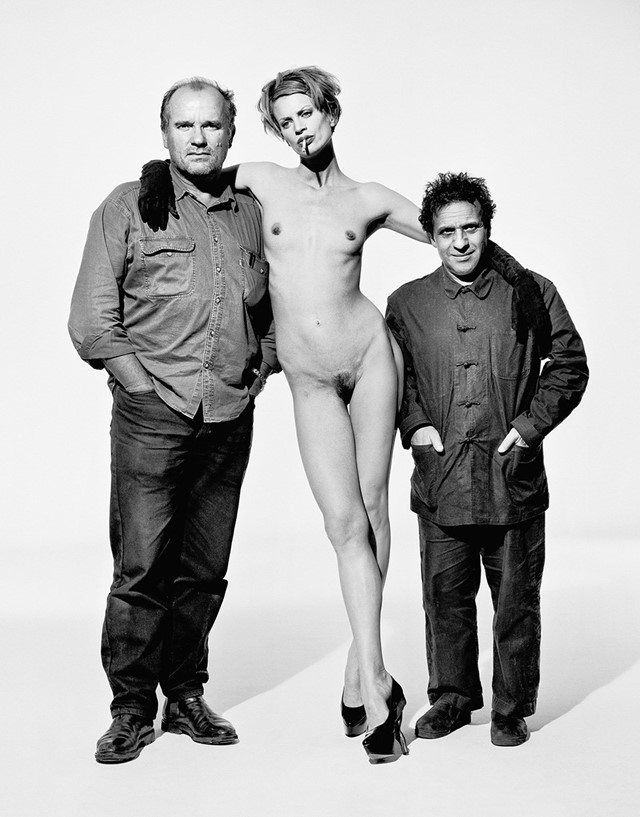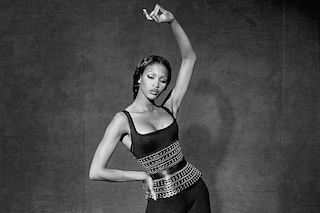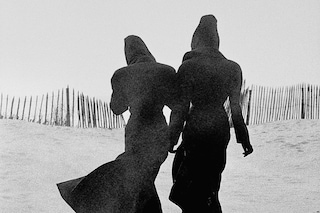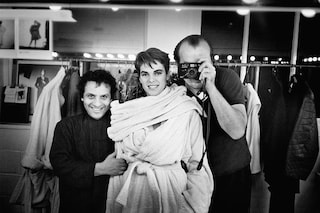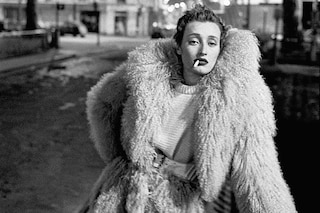As a new book documenting Azzedine Alaïa and Peter Lindbergh’s creative relationship lands, we chart the iconic designer-photographer twosomes of fashion past, present, and future
It was chance that brought Azzedine Alaïa and Peter Lindbergh to fashion. Before relocating to Paris, they were intent on becoming a sculptor and a painter, respectively. And though they hailed from opposing geographies in Tunisia and Germany, the couturier and photographer cultivated close horizons. Meeting as strangers in the French capital in 1979, the duo soon discovered that they shared the same gaze – a near ascetic use of black, a pull to timeless beauty, and a belief in the superhuman nature of women.
Be it Yasmin Le Bon striding across the puddled streets of Montmartre with a baguette under her arm and a cig dangling from her lips, or Naomi Campbell laughing on a beachfront in Deauville, Alaïa and Lindbergh’s photography ennobled their subjects with a deft use of silhouette, contour, and light, consecrating the age of the superstar model. “Peter and I have known each other since I started out. We know each other very well. We don’t even need to talk. Everything flows,” Alaïa once said of the duo’s lifelong partnership. “Azzedine and I are hand in glove,” Lindbergh later added.
This unique kinship is now the subject of an upcoming exhibition at the Fondation Azzedine Alaïa and an accompanying monograph by Taschen. Making its debut today, a flip through the pages of the book brings some of the pair’s most striking imagery to light, with many of the photographs unseen until its publication.
While the collaboration between Alaïa and Lindbergh wrote a new chapter in fashion history, they were not the first, nor the last, designer-photographer double act to strike a symbiosis – the relationship between the two disciplines is, at times, wholly interdependent. After all, designers rely on photographers to decode and translate their vision, humanising collections within much wider visual narratives. Below, we take a look at the past, present, and future of fashion photography, as told through the most iconic of its pairings.
Order your copy of the book here.
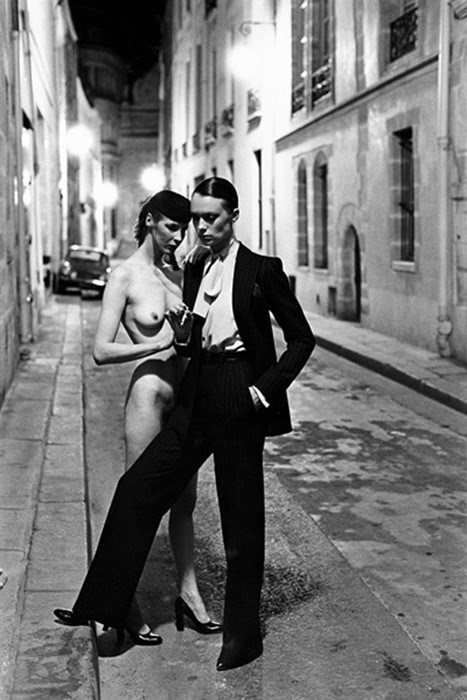 Photography Helmut Newton
Photography Helmut NewtonHELMUT NEWTON AND YVES SAINT LAURENT
Backdropped by the second-wave feminist movement, Helmut Newton rose to prominence in the 70s with a louche and scandalous approach to photography, redefining the way women, and sex, were presented in advertising. First published in the pages of British Vogue in the late 60s, Newton’s provocative lens produced some of the earliest examples of narrative storytelling in fashion photography. And it was alongside the late Yves Saint Laurent that the photographer’s will to subvert came to full fruition. Perhaps the most prominent example is Newton’s 1975 story in French Vogue, which transformed the designer’s Le Smoking jacket into the smouldering staple it is today. The now infamous photo featured an androgynous woman standing in a woozy Parisian alleyway, hair slicked, billowy cravat, pinching a cigarette, intertwined with a model dressed only in black stilettos. The image was a controversial statement on femininity and underscored the duo’s transgressive takes on glamour and desire.
RICHARD AVEDON AND GIANNI VERSACE
If Versace was designed for the mistress, not the wife, then Richard Avedon might just have made cheating understandable. Playful, poised, and sexy, the campaigns that Avedon and Gianni Versace shot together throughout the 80s and 90s are now definitive to the label’s identity. Throughout their 25 year collaboration – with a little help from a couple of stilettoed supers and a fair few wind machines – Avedon’s imagery was a striking embodiment of the era’s empowered woman. Dynamic, youthful, and fleshy. The Versace clique, a pantheon of ‘it’ girls in mini skirts and tied silk shirts, gave angles, glares, and a whole lot of drama. They knew they were hot. And that’s just how Gianni wanted it. Be it through trademark group shots, warring couples suspended in mid-flight, or entangled women seemingly stranded in sand dunes, Advedon’s orgies of glamour simply oozed Versace.
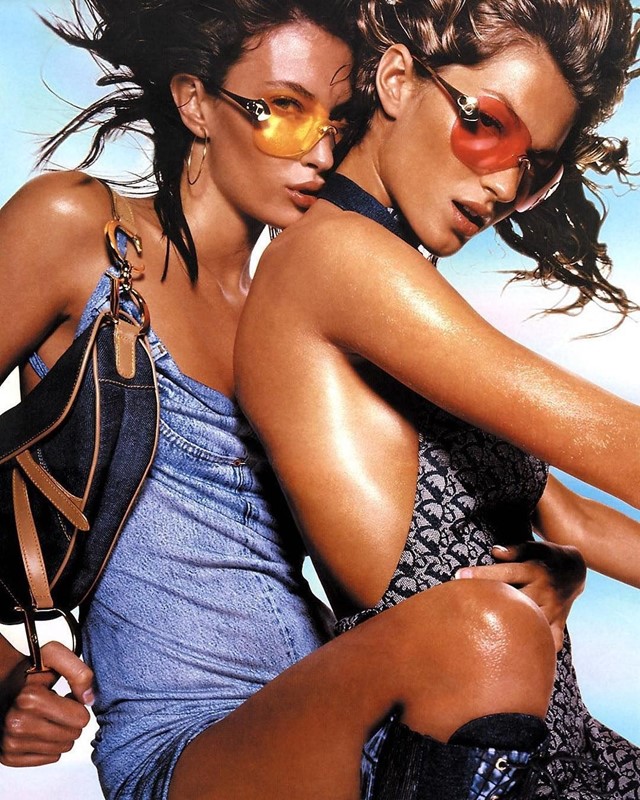 Photography Nick Knight
Photography Nick KnightNICK KNIGHT AND JOHN GALLIANO
High voltage, greased-up, violent, and bronzed, alongside Nick Knight, John Galliano ushered in an entirely new moment at Dior, taking the storied french label from the fuddy duddy to the fashionable. And, as evidenced by the innumerable Instagram moodboard accounts and Y2K Depop girlies, the era is still nourishing the young. “Let’s get sexy, let’s get sweaty, let’s get filthy!,” makeup artist Val Garland said of working the 00s Dior campaigns. And sure enough, that’s just what they did. Shooting on the inside of cars, up on scaffolded sets, and within streams of foam, both models, clothing (and, ugh, the bags) would be flecked with dirt-spray, oil, and mud. A rogue limb would often jut into frame, wrapping around a contorted Gisele, Karen Elson, or Lindsey Wixson, imbuing the shots with a wholly ambiguous but sexually charged energy. The sessions would often span days at a time, too, sometimes a week – a luxury of time, which allowed for spontaneity and sudden creative changes, something that would be unheard of now. They just don’t, or can’t, do it like they used to.
HERB RITTS AND CALVIN KLEIN
Has a photographic style ever been as distinct as that of Calvin Klein? A buffed up model, loose cut denim, crisp white undies, and a grayscale shot. It was the handwriting of Herb Ritts, whose iconic portraits of Kate Moss and Marky Mark defined the brand’s advertising for the next thirty years (and onwards, it would seem). The simplicity of Ritts’ photography dovetailed with the minimalism that Klein presented on his 90s runways, all monochromatic slip dresses and boxy LBDs. Capturing Moss on the cusp of celebrity, these Calvin Klein collaborations kickstarted the heroin chic look that would vex a decade in fashion. And the images set the body standard for men, too, which during the 90s, was all about one aesthetic: “straight-looking, masculine men, with chiselled bodies, young Greek gods come to life,” as Klein himself worded it.
JUERGEN TELLER AND MARC JACOBS
Well over a decade in collaboration, Juergen Teller’s stark, off-kilter, and flash-heavy photography has been instrumental in establishing Marc Jacobs as one of fashion’s renegade designers. "The better we got, the more confident we got, him with his design, me with my work, and the work we did together was an excellent package," Teller said of their partnership. With an eye-popping coterie of muses – from Kim Gordon, to Sofia Coppola, to Charlotte Rampling, and Winona Ryder – under Teller’s direction, Marc Jacobs straddled both celebrity and subculture. And where glamour had previously been the driving force of fashion photography, Teller and Jacobs delivered grit, glare, and grub. Their body of work is characterised by Teller’s playful and immediate style – that which captures Victoria Beckham with her legs dangling akimbo out of an enormous Marc Jacobs bag or Sofia Coppola lounging in a pool, framed by Teller’s feet. Much like Jacobs’ unflinching honesty when it comes to sex, plastic surgery, or addiciton, Teller proves that baring the ugly is sometimes the most beautiful of all.
WILLY VANDEPERRE AND RAF SIMONS
Raf Simons has championed two photographers over his expansive career. First there was David Sims, with whom he produced Isolated Heroes, a collection of portraits taken of street cast models wearing Raf’s Spring 2000 collection. And then there was Willy Vandeperre, whose vivid scenescapes have created worlds filled with Raf’s recurrent themes on isolation, the subconscious, dark romanticism, and youth. There were the blood orange skies of AW20, the Chinatown lanterns of SS18, and the barren highways of Raf’s tenure at Calvin Klein. In the photographer’s own words, their creations have always been a “reflection of post-zeitgeist, past-present-urgency, and neo-nostalgia for the future”. Both Belgium natives, the long-term collaborators first met within a group of friends on a terrace in Antwerp, and though they didn’t say a word to each other the whole night, they were intrigued, soon realising just how closely their worlds aligned. In 2016, Vanderperre paid tribute to their relationship with a limited edition box of photographs entitled 10 works for Raf Simons, ten prints that Vandeperre had found most moving. It was an ode to a career in collaboration, though, when it comes to Raf, Vandeperre always prefered to use the words “family” and “brother”.
HARLEY WEIR AND CHARLOTTE KNOWLES
“Harley is pretty genius, she just looked at the collection and understood exactly the emotions we were trying to convey, the need for something positive, the sensuality, the colours, the power. We didn’t really have to explain any concept, we were just on the same wavelength,” said Charlotte Knowles on working with photographer Harley Weir for the label’s debut campaign for SS21, a psychedelic set of images, which Weir scratched and collaged in her signature abrasive-intimate style. Throughout their work both Weir and Knowles have committed to liberating femininity from the patriarchal gaze. For Knowles, this comes in the form of warrior-like silhouettes, with pieces cinched, corseted, and strapped across the body like armour, while Weir’s portraiture prods at the boundaries of sexuality and ownership. It’s an ethos which has resonated far beyond the confines of photography, too. Knowles and Weir have collaborated on capsule collections, like Rubbish, melding together the pair’s respective points of view in full photo printed garments.
TYLER MITCHELL AND JW ANDERSON
Alongside industry stalwarts Gray Sorrenti and Steven Meisel, Jonathon Anderson has brought the young Brooklynite, Tyler Mitchell, into the JW fold – including Loewe and the designer’s Moncler collaborations. With luxury campaigns and Vogue covers under his belt, the 26-year-old Mitchell may no longer be considered up and coming, but his work has remained spirited. Like Anderson, Mitchell’s creative outlook is characterised by its carefree qualities, an optimism, and a sense of play. What an expansive trapezoid jacket and a billowing, ruffled pair of trousers does for Anderson, a sun-baked setting and pair of stilts does for Mitchell. Together, they are united by a sense of buoyancy, if not clownery. Last April, Mitchell was interviewed on JW Anderson’s Instagram about what makes their collaboration so strong. “When he first called I was immediately excited,” said Mitchell, “I really love his collections, I really love his work”.
RUTH OSSAI AND MOWALOLA
Initially connecting with Ruth Ossai over Instagram, Mowalola first collaborated with the West Yorkshire photographer back in 2017 whilst she was a student at CSM. With styling from Dazed’s Editor-in-Chief, Ib Kamara, Mowa described her nascent collaborators as “unapologetically Black”. The images which followed were a celebration of Mowalola and Ruth’s homecountry, in particular the psychedelic rock of 80s Nigeria. Since then, Ossai and Mowa have looked to Nollywood, Nigerian highlife music, and 90s Lagos to finesse their visual identity, bringing sound, sexuality, and vibrancy to the designer’s clothing. Together, they have produced music videos, books, and countless editorials, always retro inflected and steeped in nostalgia. “We’re drawn to that grainy, VCR quality you get in the ’90s videos, all the cool special effects and transitions,” Mowalola explained to Vogue. “No one does that anymore, everything you get is so clean now.”
